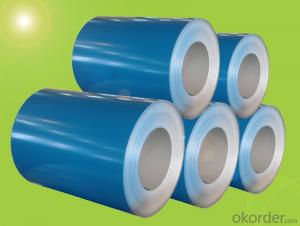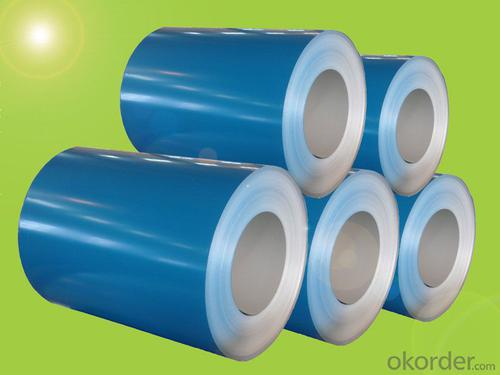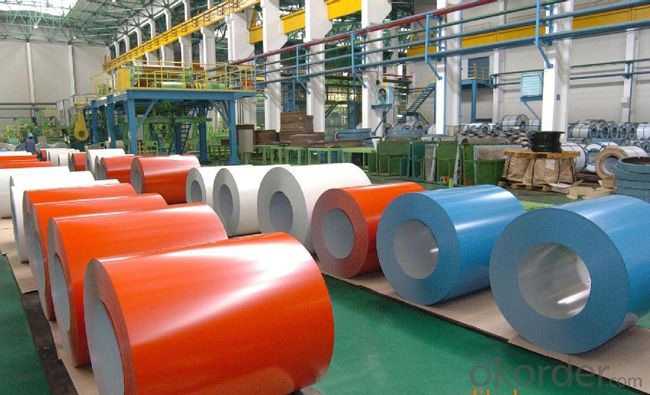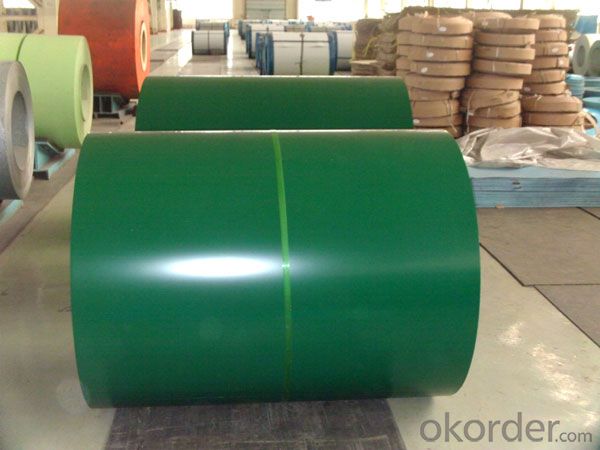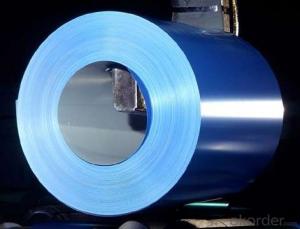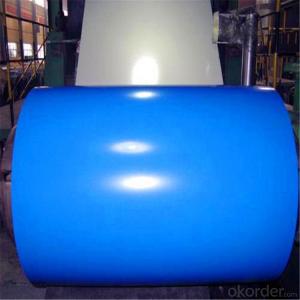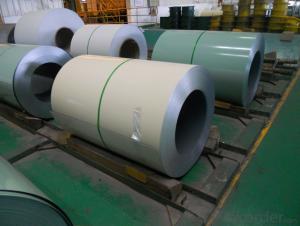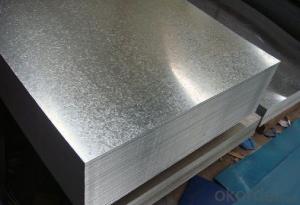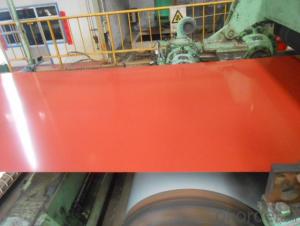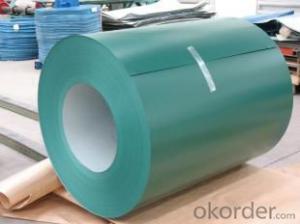High Quality PPGI
- Loading Port:
- China Main Port
- Payment Terms:
- TT OR LC
- Min Order Qty:
- -
- Supply Capability:
- -
OKorder Service Pledge
OKorder Financial Service
You Might Also Like
Product Features
super weather resistance and durability , also the pattern is capable to bring about plenty of effects of multilayer, parallax and 3D effect.
Application
It is the perfect building material in construction for making steel roofing/suspended ceiling, office partition, Sandwich panel, insulation panel, corrugate sheet, facade wall,rolling doors, T-bar, garage door and shutters etc.
Structure of Cross-section
Items | Thickness | Type | Features |
Protection Film | 50μm | polyethylene | Protecting from scratches and |
Finished Coat | 10μm | PVDF | Protecting printed layer and enhances |
Print | ≦1μm | Ink, Polyester | Various printing patterns,3 colors overprint |
Top Coat | 20μm | Polyester Fluorine | Chemical resistance, formability and |
Primer Coat | 5μm | Polyester | workability, corrosion resistance and |
Chemical Treatment | ≦1μm | Chromate | Good adhesion and corrosion resistance |
Substrate | 0.2-1.2mm | GI.GL.AL | GI.GL,AL |
Chemical Treatment | ≦1μm | Chromate | Good adhesion and corrosion resistance |
Back Coat | 5μm | Epoxy | corrosion resistance and adhesion to the |
- Q: What are the common methods of cutting-to-length steel coils?
- Depending on the industry's specific requirements and capabilities, there are various common methods used to cut-to-length steel coils. 1. Shearing: For thinner gauge materials, one can utilize shearing, which involves using a shear blade to cut the steel coil into specific lengths. This cost-effective method is ideal for high-volume production. 2. Slitting: For narrower strips or multiple widths from a single coil, slitting is a suitable process. It entails passing the steel coil through rotating circular blades that cut the coil into desired widths. Slitting is commonly used for thinner gauge materials. 3. Laser cutting: To achieve precise and clean cuts, laser cutting employs a high-powered laser beam that melts and vaporizes the steel coil. This method is versatile, suitable for a wide range of materials, complex shapes, and contours. Laser cutting is often chosen for high-precision applications and smaller production runs. 4. Sawing: Thicker gauge materials are commonly cut using sawing. This method, which can be done manually or with automated sawing machines, involves using a saw blade to cut through the steel coil. Sawing is ideal for cutting large sections or heavy-duty applications. 5. Rotary cutting: Rotary cutting is frequently employed for thicker gauge materials in high-speed production. This method utilizes a rotary shear to cut the steel coil into desired lengths, providing a clean and accurate cut. Many industries prefer rotary cutting. It is important to consider that each method has its own advantages and limitations. The appropriate cutting method selection depends on factors such as material thickness, coil width, required precision, production volume, and budget constraints.
- Q: How are steel coils used in the production of food processing machinery?
- Steel coils are used in the production of food processing machinery as they are commonly used to create the structural frames and components of the machinery. Additionally, steel coils are often used to manufacture cutting blades, conveyor belts, and various other parts that require strength and durability in the food processing industry.
- Q: I have a new stainless steel trash compactor under a butcher block counter. We refinished the countertop, but unfortunately the person who did it wasn't careful with the orbital sander and sanded the top edge of the stainless steel compactor door, ruining the finish. The sander marks are not deep - just surface scratches - but they are unsightly. Is there any way to restore the finish to the stainless steel without having to buy a new door?
- This Site Might Help You. RE: How to refinish stainless steel appliance? I have a new stainless steel trash compactor under a butcher block counter. We refinished the countertop, but unfortunately the person who did it wasn't careful with the orbital sander and sanded the top edge of the stainless steel compactor door, ruining the finish. The sander marks are not...
- Q: What are the common size limitations for steel coil production?
- The common size limitations for steel coil production depend on various factors such as the type of steel, manufacturing equipment, and transportation constraints. However, generally speaking, steel coils are typically produced within a range of widths between 600mm to 2,000mm, with thicknesses ranging from 0.2mm to 25mm. The maximum weight of a steel coil is usually around 25 metric tons, although this can vary depending on the specific production facility and transportation capabilities.
- Q: What are the main factors that affect the quality of steel coils?
- The main factors that affect the quality of steel coils include the composition and purity of the steel, the manufacturing process, temperature control during production, and the level of surface defects or imperfections. Additionally, the storage and handling conditions, as well as the expertise of the manufacturer, can also impact the quality of the steel coils.
- Q: What is the average amount carbon emissions of steel per pound produced?
- Carbon okorder /... - Similar pages - Life-cycle energy and emissions of marine energy devices | Carbon ...Carbon dioxide emissions per unit mass of steel: 1.75 tCO2/tonne steel ; Total mass of steel in device: 665 tonnes ; Carbon dioxide emissions due to .
- Q: I installed it, added it in F3 launcher and then after one minute of walking in wasteland I get a signal that Broken steel was added and that my level of caps was raised by 30. However after this message no quest is added. I played all 4 exp. packs and I had no problem at all, each time a new quest was added. So whats up with this Broken steel. Btw, I completed the entire game F3.
- Broken Steel doesn't begin until the main quest ends.
- Q: What are the common coil sizes available for steel coils?
- The common coil sizes available for steel coils vary depending on the specific industry and application. However, there are several standard coil sizes that are commonly used across different sectors. These include 36-inch, 48-inch, 60-inch, and 72-inch coil widths. In terms of coil diameter, the most common sizes are typically between 20 inches and 24 inches. Additionally, coil weights can range from a few thousand pounds to several tens of thousands of pounds, depending on the type of steel being coiled and the intended use. It is important to note that these sizes may vary among different steel manufacturers, so it is always advisable to consult the specific supplier or industry standards to determine the available coil sizes for a particular steel product.
- Q: I'm analysing horse stirrups and would like to know the disadvantages to stainless steel? - thanks
- For horse stirrups the main disadvantage to stainless steel is the manufacturing cost. Stainless steels tend to work harden, and are subject to their own peculiar forms of corrosion, but I see little implication to either of these factors when used as a stirrup iron or a safety latch. Stainless steel is also subject to self welding, or galling, this would be of no concern for the irons, but could result in the pivot of the safety latch freezing (I have never known anyone to ride with the safety latch closed, however).
- Q: How are steel coils used in the production of metal bridges?
- Steel coils are an essential component in the production of metal bridges due to their versatility, strength, and durability. These coils are typically made from high-quality steel alloys, which provide the necessary structural integrity required for constructing bridges. The first step in using steel coils for bridge production is processing them through a series of manufacturing techniques. The coils are uncoiled and straightened to remove any distortions or bends. Then, they are cut into precise lengths according to the bridge's design specifications. Once the steel coils have been processed, they are transformed into various structural components used in bridge construction. These components include beams, girders, trusses, and plates. Beams and girders are typically used for the main support structure of the bridge, while trusses provide additional support and stability. Plates are used for the bridge deck, providing the surface on which vehicles and pedestrians travel. Steel coils also play a crucial role in the fabrication of bridge connections and joints. These connections are essential for transmitting loads and forces throughout the bridge structure, ensuring its stability and safety. Steel coils are used to create various connection elements such as bolts, nuts, washers, and welded sections. Furthermore, steel coils are commonly employed in the production of bridge reinforcements. Reinforcing steel bars, also known as rebars, are manufactured from steel coils. These rebars are used to strengthen concrete elements within the bridge, such as columns, piers, and abutments, enhancing their load-bearing capacity and resistance to bending and tension. In addition to their structural applications, steel coils are also used for protective coatings on metal bridges. Coils can be coated with specialized materials such as zinc, epoxy, or paint to prevent corrosion and increase the lifespan of the bridge. These coatings help to maintain the structural integrity of the bridge, especially in harsh environments where exposure to moisture, chemicals, and weathering factors is high. Overall, steel coils serve as the backbone of metal bridge production. They are transformed into various structural components, connections, reinforcements, and protective coatings that ensure the strength, durability, and longevity of the bridge.
Send your message to us
High Quality PPGI
- Loading Port:
- China Main Port
- Payment Terms:
- TT OR LC
- Min Order Qty:
- -
- Supply Capability:
- -
OKorder Service Pledge
OKorder Financial Service
Similar products
Hot products
Hot Searches
Related keywords
